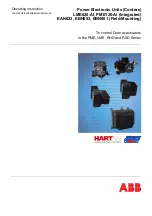
15
ECL is selected, the polarity of the logic output
is specified by the "OP" command. If the
VARiable output mode is selected, then the
output amplitude and offsets may be set with the
"OA" and "OO" commands. Example: the
command "OM 6,0" selects TTL levels (0 to
4VDC) for the D output.
OA i{,v}
Amplitude of output i is set to v Volts if in the
VARiable mode. This command is used to set
the amplitude, i.e. the size of the step, at an
output BNC. The maximum step size is limited
to ±4 Volts: the minimum step size is ±0.1VDC.
The specified step size must not cause the
output level (including the programmed offset)
to 4V or -3V. Example: the command
sequence "OM 5,3; OO 5,0 ; OA 5,4.0" will
select the VARiable mode for output C, zero its
offset (see below) and set its amplitude to
4.0VDC. Note the importance of setting the
offset: if the offset was set to a level greater
than zero, the command "OA 5,4.0" would
generate an error because the programmed offset
plus amplitude would exceed the +4VDC
maximum.
OO i{,v}
Output Offset of output i is set to v Volts if in
the VARiable mode. This command is used to
set the offset of an output when in the VARiable
mode. For pulses which have a rising edge
output, the offset is the voltage between the
lowest output level and ground, and so a TTL
signal has zero offset and +4VDC amplitude,
while an ECL signal has -1.8VDC offset and a
+1VDC amplitude. To invert the polarity of the
pulse, i.e. for a falling edge output, a TTL
output is described as a +4VDC offset an a -
4VDC amplitude pulse, and an inverted ECL
pulse is described by a -0.8VDC offset with a -
1.0VDC amplitude.
OP i{,j}
Output Polarity of channel i is inverted (j=0) or
normal (j=1) for TTL, ECL or NIM outputs.
This command sets the polarity of logic pulses
at the BNC outputs. In all cases, normal polarity
means that the output will provide a rising edge
at the specified time. Example: the command
sequence "OM 5,2; OP 5,0" will set the C output
for an inverted ECL output, i.e., the output goes
from -0.8VDC to -1.8VDC when the channel
times out.
TRIGGER COMMANDS
TM {i}
Set Trigger Mode to Int, Ext, SS or Bur (i=0,1,2,3).
This command selects between Internal, External,
Single-Shot, or Burst trigger modes. Other trigger
commands are then used to completely specify the
trigger conditions: TR will set the internal trigger
rate, TL and TS set the trigger level and trigger
slope for external triggers, SS is used to execute a
single shot if in the SS mode, and BC and BP set the
burst count and burst period for the burst mode. The
TR, TL, TS, BC, and BP commands may be
executed at any time, regardless of the trigger mode.
Example: The command "TM 0" selects the internal
rate generator as the trigger source.
TR i{,f}
Set Internal Trigger Rate (i=0) or Burst Trigger Rate
(i=1) to f Hz. The frequency may be any value
between 0.001 Hz and 1.000MHz. The precision is
0.001Hz below 10Hz, or 4 digits if above 10Hz.
Other digits will be truncated. The internal rate
generator will settle to the programmed value within
2 seconds after the command is executed: significant
departures from the programmed value may be
expected during the 2 second settling period. (A
simple way to disable triggers during this settling
time is to select the single-shot trigger mode, i.e.
"TM 2".) Example: the commands "TM 0; TR
0,100.2" will select the internal trigger mode and set
the trigger frequency to 100.2Hz.
TL {v}
Set External Trigger Level to v Volts. This
command sets the threshold voltage for external
triggers. To completely specify the external trigger,
the TS (trigger slope) command must also be used.
Example: "TM 1; TL 1.00; TS 1" specify the
external trigger mode, with the trigger level at
1.00VDC, with a positive slope. These values would
be appropriate for triggering on the rising edge of a
TTL logic pulse. (Also see the TZ 0{,j} command
which sets the input impedance for external
triggers.)
TS {i}
Trigger Slope set to falling (i=0) or Rising Edge
(i=1). This command selects the slope condition for
external triggers. It is used with the TM, TL and TZ
commands to specify the conditions for an external
trigger. Example: the command "TM 1; TL -1.2; TS
1; TZ 0,0" specify the external trigger mode, a
trigger level of -1.2VDC, a positive trigger slope,
















































